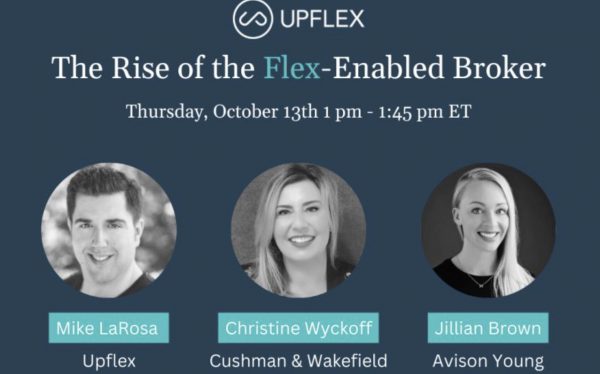Upflex partners from Cushman & Wakefield and Avison Young join VP of channel partnerships Mike LaRosa to share how brokers are looking into the future with better, richer, more accessible flex and hybrid workspace utilization data.
I always joke that, for as much as we work on flex workspace solutions, I really spend more of my day talking about one thing: data. Constantly, I’m having conversations with Upflex’s CRE partners about flex space usage data, from how to safely collect it, to how to safely process it and use it, and every variance you can think of on particular opinions around this topic.
In my experience, brokers, for some time, tended to be a little resistant towards flex, or maybe they didn’t understand it, or they saw it as maybe a little bit disruptive or competitive. But when it comes with usage data that allows you to track, measure and iterate a sustainable flex strategy, flex is not just a solution — it’s actually a new product.
Traditional flex reporting used to be limited to hindsight: This is how much you spent this month. This is how many people — if they could even do card swipes — came through your workspace.
But now, as technology has advanced — the product team here at Upflex has put a tremendous amount of effort into really bringing data and insights to the next level and making them actionable for our partners and occupiers — we’re seeing something else: For example, I worked with a recent client who saw utilization data for a hot desk membership program, and they’ve now converted into a hub. The move means their strategy is now more cost-efficient, and they’re accommodating more employees, which is helping them with both acquisition and retention in a competitive market.
At Upflex, we’ve been working closely with brokers to design customized solutions for their corporate clients, and we’re definitely not alone in seeing that occupiers are looking for more flexibility and control when it comes to their workspace. In our recent webinar on the rise of the flex-enabled broker, I asked Upflex partners at Cushman & Wakefield and Avison Young what other ways can a broker leverage flex as a tool rather than view it as a hindrance.
 Here’s a slice of that conversation:
Here’s a slice of that conversation:
Christine Wyckoff, Cushman & Wakefield: I say: Embrace it, embrace it, embrace it — because it’s so good. I saw this internally, here, because I do not compete with brokers, I am not a broker — our platform sits to support them, so they can lean on us to assist in helping them solve for global requirements, whereas before they were just doing something in the relevant market, so here we’re talking to brokers to say okay, so I can help you and your client set this up globally, right, and we can do these programs globally. And then you have flex team support that is in other markets as well.
I think it’s an opportunity to partner internally, collect the data, and then the story will tell itself: What’s the next best step that you can advise your client?
If we know that you’re in a market, and we have someone now that’s over-utilizing a drop-in space, the data tells the story of what’s right next to it. When the broker combines that with the longer-term plans and market strategy, marrying them together, all of a sudden he or she is in a powerful place. That broker has the ability to say, ‘Here’s where I think you need to be, and here’s why.’ There’s a data behind it. Here’s real-time data. Here’s how you control the costs. I think if they can off shake the fear and embrace it — it’s just a different a different approach — and then once they understand it, they see that their clients are embracing it from the C-suite down. It’s really changing how they think about things.
Jillian Brown, Avison Young: We should always be looking at the client first. Brokers are very, very knowledgeable about their specific markets or assets and they’re delivering. But flex is here — and it’s not going anywhere.
So, how do we increase that knowledge and awareness of what flex can offer, but also bring the data behind it to tell the broker that you know what we can help you solve for your client’s needs and in San Francisco, and in Denver, and guess what Intel event and in Berlin and in Stockholm? We can do that from sitting you know, here in the Americas and at a global level and really bring your client that tremendous value, and both the education and then de-risking and adding some flexibility to their portfolio — and guess what, brokers: You’re going to have that data, and be able to see and understand and, in a sense, give you a crystal ball.
As to what are the proactive strategies and approaches that we should be assessing and bringing to this client moving forward are: If we’re seeing they’re over-utilizing the space or you haven’t touched that 20-person office that you thought you needed while, in the meantime, your employees are dropping into spaces and meeting rooms every day, how do we share that?
It comes down to the tools and platforms that are finally empowering brokers and occupiers with this data on flex that can really help people plan for the future.
Watch the full discussion on The Rise of the Flex-Enabled Broker here:


